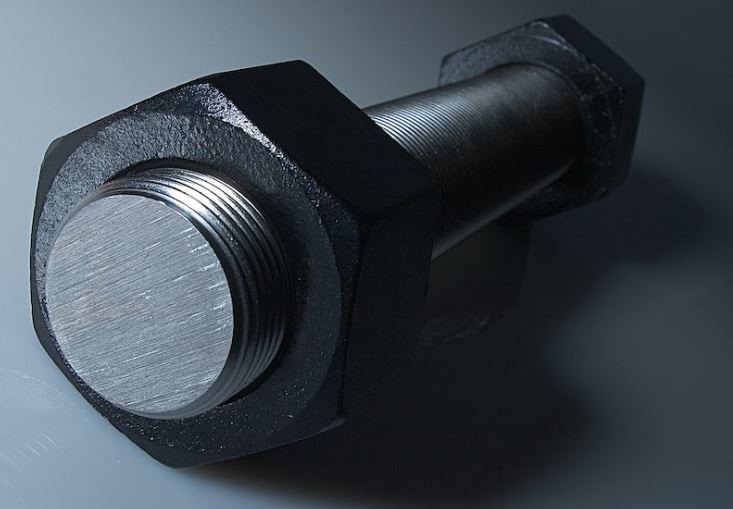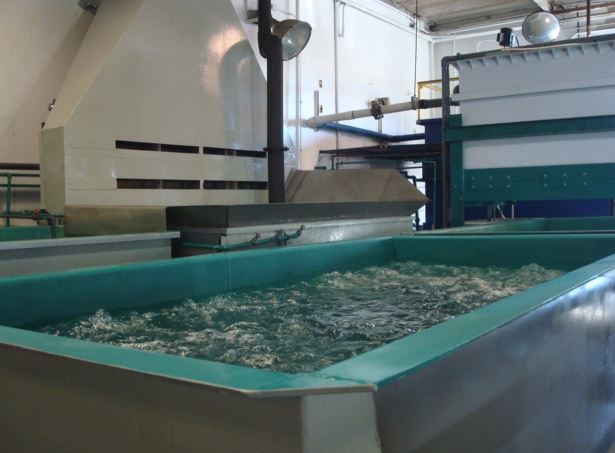
Part with Black-oxide finishes
Surface finishing of products and parts is essential in the manufacturing industry for aesthetic reasons and improves the product’s overall functionality, and extends its life. The black-oxide finish is a chemical coating process that deposits a microscopic layer of magnetite (Fe3O4) over the surface of metal parts. Due to exposure to air and moisture, rust commonly forms on the surface of ferrous parts after a while. A black-oxide finish resists corrosion and smooth’s the surface of ferrous and other materials such as cast iron, cast steel, stainless steel, copper, zinc, aluminum, brass, and chromium.
How does it work?
The black oxide is formed on the material surface when immersed in alkaline salt solution at a suitable temperature (130 to 150 0C). The thickness of the coating is negligible, so it does not affect the dimension stability, design parameters, and properties. You may be wondering why it is called black-oxide finishes? It is because it ultimately blackens the finished surface.
Steps of the black oxide coating
There are mainly five steps in coating black oxide on the material’s exterior to complete the surface finishes.
Step 1: Check the quality of the surface smoothness. If there are blink holes, rust, or surface irregularities, eliminate the risk of Flowering or bleed-outs with the appropriate approach.
Step 2: Clean the surface to remove any dust and attached materials from the surface before the coating.
Step 3: Apply the back oxide coating
Step 4: Again, clean the surface after the coating.
Step 5: Apply the after-finish coating such as Oil, Polyurethane, lacquer, Wax, and lubricants in some cases (Screws, Bearing, Turbine parts, and other rotatory components). Because black-oxide finishes alone cannot prevent rust formation effectively, these after coatings improve corrosion resistance.
Types of Black-oxide finishes
Based on the materials and end-use application of the parts to be coated. There are three approaches for black-oxide coating: Hot black oxide, Cold black oxide, and Mid-temperature black oxide. Although there are other approaches for surface finishes with Black- oxide coating. The fundamental distinction between these methods is that their formulations and operating temperatures are different. Let’s look at the two most common types of them in detail.
1. Hot black-oxide coating
In this procedure, pieces are placed in a boiling furnace with aqueous alkaline solutions, such as sodium hydro oxide (NaOH), nitrates (NO3-), and nitrite (No2-), at temperatures ranging from 135 to 150 0C. The salt concentration in the solution determines the boiling temperature. If the concentration is high, the boiling point will be higher than the range (> 150 0 0C), and if the concentration is low, the boiling point will be lower (0C). The advantages of this property are that we can quickly establish the desired temperature by modifying the salt content, i.e., add salt if the boiling point needs to be increased, and so on.
This form of black oxide coating or the surface finish requires three specialized facilities.
- Blast furnace with an alkaline salt solution to convert iron oxides into liquid iron on the surface.
- Temperature control system to maintain the required boiling point.
- Cleaning facilities to remove the dust and attachment on the surface throughout the process

Boiling solution with parts to be coated
Steps to follow:
- Clean the parts that will be coated using an alkaline aqueous solution.
- Clean instantly with distilled water, as alkaline solutions can react with the surface of the material and degrade the primary surface finish
- To neutralize the acid cleansing, clean with water once more.
- For 5 to 45 minutes, submerge the pieces in a boiling alkaline solution.
- Clean with pressurized water using a water jet and set aside to dry.
- Apply wax, oil, lacquer, or other secondary coating materials to the secondary finishes to improve corrosion resistance and aesthetic appeal.
2. Cold black oxide finishes
As mentioned before, the operating temperature is the main difference between hot and cold black oxide finishes. All the procedures are the same besides that cold blackening on surfaces carried out at room temperature.
Since iron oxide cannot be liquidated at room temperature on the surface, it is rather than deposition a black layer on the surface to be coated. Therefore, it employs a standard deposition process that does not include iron oxidation. Instead, surface coating parts are dipped in a phosphoric acid tank solution with a reasonable degree of selenium copper and compounds.
To operate the surface finish with this approach, the solution gets created in the tank, and each batch of parts is immersed in it for 20 to 30 minutes. All other cleansings, drying, and secondary coating of wax and oil are the same as the hot black oxide finishes.
Scenario | Hot black oxide finish | Cold black oxide finish |
Coating compound | Iron oxide, called Magnetite (Fe3O4) | selenium copper and compounds |
Operation Time | 5 to 45 minutes | 20 to 30 minutes |
Operating temperature | 135 to 150 degrees Celsius | Room temperature (20 to 25 °C) |
Durability | More | Less |
Accuracy | It gives more dimension stability than cold black oxide finishes | It has less dimension stability because it is a simple deposition approach |
Cost | More, it required a lot of facilities, heating, temperature control, and others. | Less, It requires deposition solution (phosphoric acid) |
Operation security | A lot of safety and precautions due to high operating temperature | Excellent |
Applications of Black-oxide Finish
Parts with metal-oxide coating from various industry
The Black-Oxide surface finishes are used in various manufacturing fields ranging from Military, Automotive to medical devices and equipment.
Military: Gun components such as Magazines, handguards, shells, grips, handguns
Medical: All the types of equipment made from metal and alloys that needed to be low reflectivity surface
The hardware of manufacturing tools: Gauges, cutters, fasteners, bearings, shafts, and more
Automotive: Oil filter can’s, Screws, Welding locations, and almost all parts under the Engine block
Electrical: Wire remover, scissors, cutters, and gearboxes for clocks and electric appliances such as switches, boards
PRO and CONS of Black oxide- finishing
PROS:
A black oxide coating on produced components and goods provides several advantages in terms of security, longevity, functionality, surface smoothness, and aesthetic appeal. Let’s take a quick look at each of them.
Prevention from Corrosion:
The present manufacturing industry relies significantly on ferrous alloys, particularly steel. The black oxide layer seals the part’s surface from air and moisture, reducing the chance of rust formation, which is a significant cause of product degradation. Since black oxide surface finish approach can also be used for other common materials like copper and aluminum. It has a huge advantage in maintaining the durability of manufactured products.
Aesthetic benefit
It offers the surface a gorgeous and appealing black color that will last a long time without any dimension compromise.
Lower reflection
Most of the Metal pieces have a high reflection. It can be a problem for those who work in the radiation industry. Black coating with oxidation of iron reduces the reflectivity significantly.
Weldability advantage
Welding the black oxide finishes on the pieces’ surfaces improves their weldability and makes assembly easier.
The surface sharpness
Some manufacturing goods, such as drills and screwdrivers, require a sharpness to function correctly, and blackening can help to improve this character.
Lubrication
After the black oxide has dried on the surface, a secondary coating of wax, oil, and lubrication makes things easier.
Low-cost
There are other precise surface finishing methods in the manufacturing industries like powder coating, electroplating, and painting but black oxide coating has a low cost compared to these approaches.
Dimensional consistency
Black oxide coatings are micron-thick, ensuring that thickness and dimensional stability are not compromised. This method changes the color of the surface without adding any thickness.
Environmental stability
Using a black oxide finish on the surface of manufactured parts and goods prevents hydrogen diffusion and chemical changes, which impact the material’s characteristics due to environmental factors. It also provides environmental protection against environmental effects.
CONS
- The black oxide covering could easily be rubbed off.
- This type of surface treatment is labor-intensive because it involves numerous processes.
- The temperature resistance of the black-oxide coating is low, and it can be destroyed in hot conditions, resulting in early rusting on the surface. In addition, the cold black oxide finishes can be affected beyond the ambient temperature.
Factors to be considered in the black oxide-finishes
Protection Timeframe
Before going through the black oxide protection on the product surface, the required coating duration should be considered.
This analysis aided in determining whether a black oxide surface finish should be used or not. If the product’s longevity is poor, you may want to consider other simple options, such as paint coating. It’s only worthwhile if the product life cycle is longer.
The product’s final application
Consider the end use of the machined parts. Will they be used in applications that need high precision, such as aerospace, robotics, or military applications? Determine whether you want to go with black oxide finishes or not after examining the final use application. You can use alternate surface finishing and coating processes if the end-product does not require high precision.
Environmental considerations
Black oxide-coated items or parts can withstand a range of environmental conditions. It has good durability and operation without any damage in the out-of-the-box state.
However, if the ultimate product is intended for indoor usage, it may not be cost-effective or technologically feasible. Also, the operating and using conditions have a high temperature. In that case, it might not be beneficial because the black oxide coating could disintegrate in a short period at a high working temperature. Thus environmental factors should be considered when using this technique for surface finish.
FAQs regarding black oxide finishes
Is this approach only work for ferrous materials?
No, back oxide coating has been used for a long time in the surface finishing of manufacturing parts and products made from ferrous alloys and other materials such as copper, aluminum, Cadmium, Zinc, and other common materials.
Is it the best way to prevent the rusting?
Yes, the coated black oxide resists the moisture and air reacting with the surface and gives excellent prevention over the rusting of parts.
Is the blackening last for a long time?
Without any doubt, coating lasts for a more extended period than other surface finishing approaches such as electroplating and painting.
Conclusion
Black oxide finishing is the most promising technology for preventing corrosion and surface degradation in machined components and products. It can also survive for longer without losing its features or functionality. we has long provided manufacturing services under one roof, from prototype design to product finishing, learn more about our surface treatment service.
We have delivered high-quality surface finishing services for products and parts using the black oxide method and other processes. If you require any associated services for your machined parts or other manufacturing-related services, please do not hesitate to contact us.
Media Contact
Company Name: Pro-Lean Technology Co., Ltd.
Email: Send Email
Country: China
Website: https://www.proleanhub.com/













